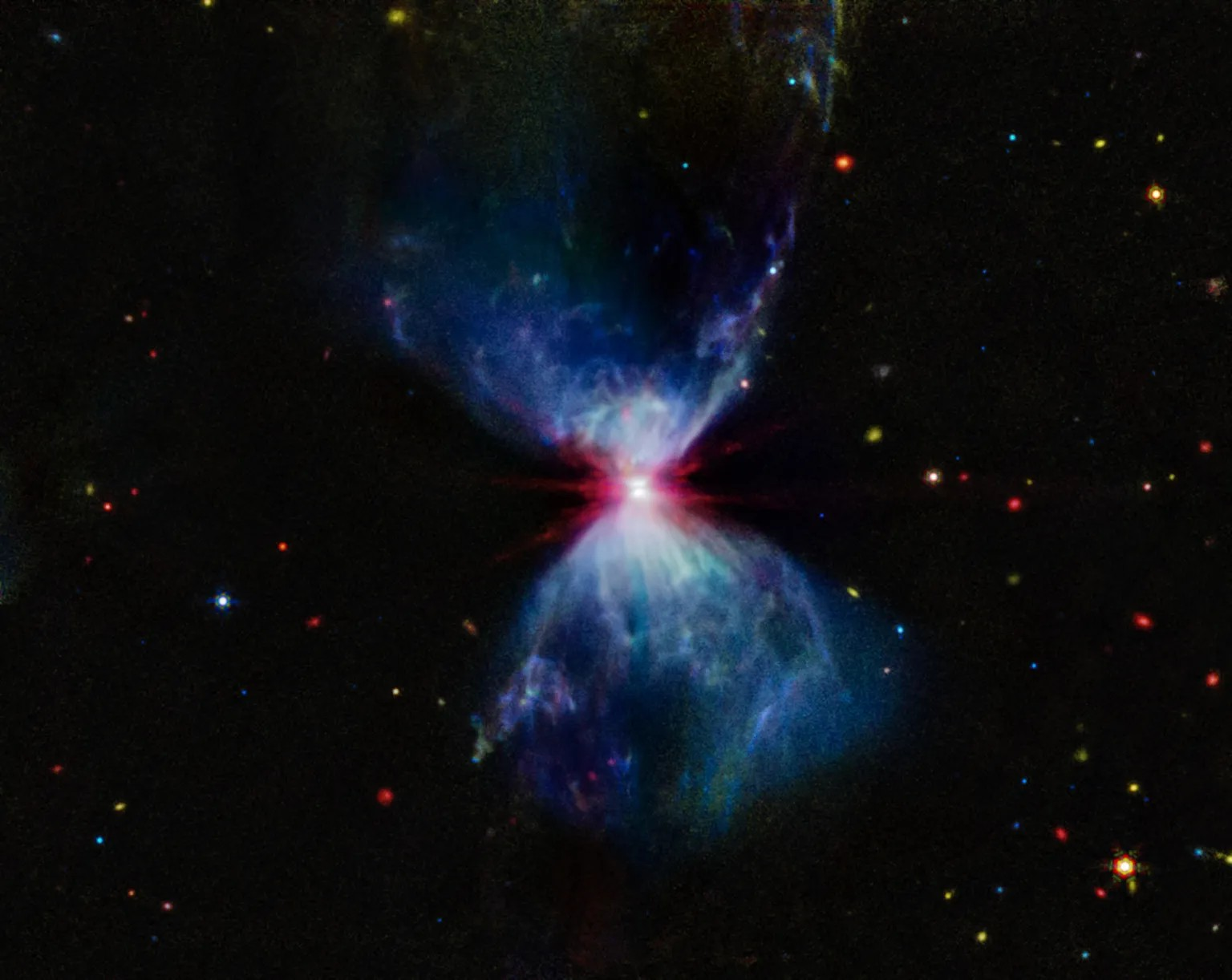
11 Marshall Team Members, 5 Teams Awarded in Space Flight Awareness Ceremony
By Jessica Barnett
Sixteen individuals and groups from across NASA's Marshall Space Flight Center were recognized June 27 for going above and beyond in their support of the human space program.
Marshall Deputy Director Rae Ann Meyer presented the awards during a special Space Flight Awareness ceremony in Activities Building 4316.
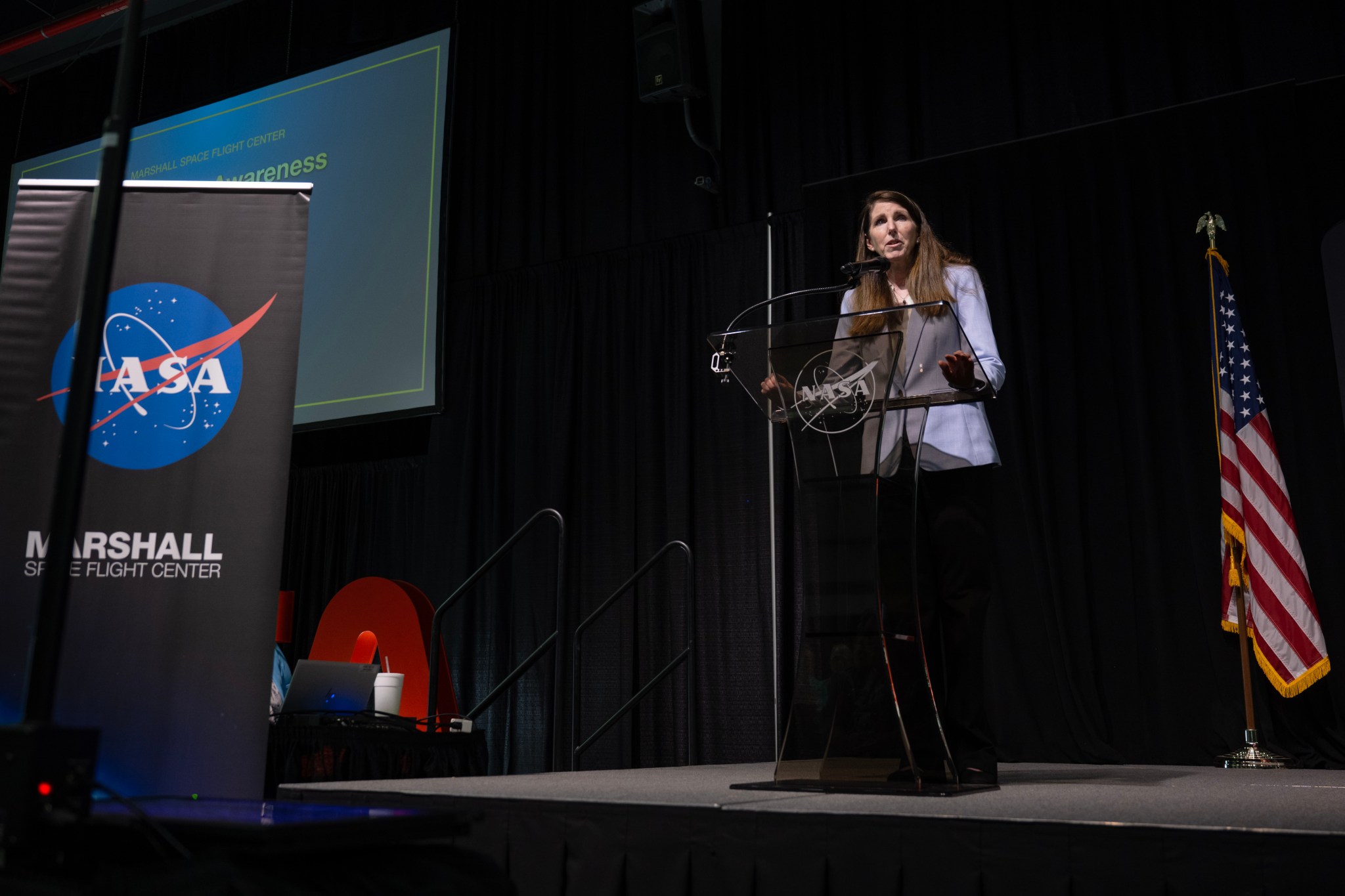
"I am honored to be part of Marshall's talented and dedicated workforce, with all we accomplish," Meyer said. "Celebrating your commitment to keeping our astronauts and our missions safe through your daily work is a true joy. Your ability to innovate, lead, and manage successful teams is inspiring."
Of the 16 awards presented, nine were awarded to SFA Trailblazers. These individuals, each in the early stages of their career, demonstrate a strong work ethic and creative, innovative thinking in support of human spaceflight.
Two Marshall team members received the SFA Management Award, which aims to recognize mid-level managers who consistently demonstrate loyalty, empowerment, accountability, diversity, excellence, respect, sharing, honesty, integrity, and proactivity.
In addition, five teams received the SFA Teams Award in recognition of their exemplary teamwork while accomplishing a particular task or goal in support of the human space program.
The full list of winners is below:
Trailblazers
- Josie Blocker
- Savannah Bullard
- Austin Lee
- Kaitlin Oliver-Butler
- Nicholas Olson
- Elvis Popov
- Gwyer Sinclair
- Timothy Wray
- William Till
Management
- Jennifer Franzo
- John Sharp
Teams
- Safety Mission Assurance Software Assurance Launch Support Team, Artemis I Team
- SLS (Space Launch System) Engineering Imagery Team
- Mars Ascent Vehicle Verification and Validation Team
- SLS Coupled Loads Analysis Team
- ECLSS (Environmental Control and Life Support Systems) Flight Systems Design and Analysis Team
The SFA Trailblazer, Management, and Team awards are three of eight awards presented annually by Space Flight Awareness. Additional information, including eligibility criteria, can be found here.
Barnett, a Media Fusion employee, supports the Marshall Office of Communications.
Marshall's Hot Gas Facility, Team Provide Critical Testing Capability
By Wayne Smith
The Hot Gas Facility at NASA's Marshall Space Flight Center can really take the heat - up to 3,000 degrees Fahrenheit - creating a test environment geared for making human space exploration safer.
Mitigating human risk and returning Artemis II astronauts safely to Earth is paramount as NASA prepares for its first crewed mission aboard the Space Launch System to the Moon in more than 50 years. Engineers use the Marshall facility to simulate launch conditions for testing SLS hardware, the TPS (thermal protection system), and other materials in a Mach 4 environment - four times the speed of sound.
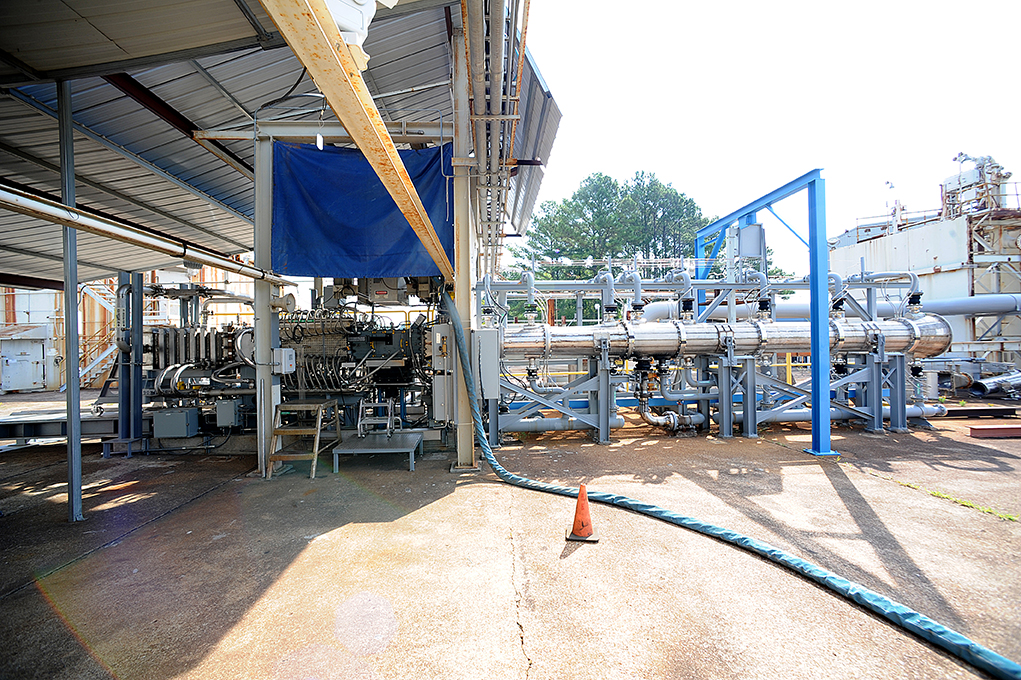
"At NASA, we live on the idea of 'test like you fly,'" said Malik Thompson, Commercial Crew TPS subsystem manager. "It's very difficult to replicate the entirety of space and the environment that gets you there. It's a unique capability - and the only one in the entire world."
The current Hot Gas Facility has been in service for 37-plus years and has completed more than 27,000 hot firings. It was built to develop, characterize, and qualify TPS materials for flight vehicles, but has proven to be invaluable for addressing in-flight anomalies and performing material and instrumentation studies. It has qualified materials for NASA crewed and uncrewed flight vehicles, as well as for Department of Defense and commercial vehicles.
During tests, combustion products are expanded from the combustion chamber through a two-dimensional nozzle into a 16×16 inch test section. A Mach 4 flow environment is induced, along with heating rates up to 3,000 degrees Fahrenheit. It can induce convective and radiant heating simultaneously to accurately simulate flight conditions during ascent. The facility has 512 channels of instrumentation to support a variety of engineering measurements and test scenarios.
The facility's flexibility, and its innovative and experienced crew members, means NASA can accomplish testing more quickly and at considerably less cost when compared to large national test facilities.
"Conditions and configurations can be adjusted during a test program to address issues as they arise," said Greg Vinyard, a Marshall engineer who has worked 38 years at the facility. "This flexibility is valuable for small and large-scale research and development programs. The experienced crew adds to the unique capability, working with customers to provide innovative methods to address the requirements of a test program and maximize the results of the testing."
The facility served as the benchmark for the recession characteristics of space shuttle TPS materials and historically has been "the acid test" - if a material survives the Hot Gas Facility environments, the material will survive flight environments.
"Freeing a launch vehicle from the surface of Earth is a huge part of space travel, and you need a lot of acceleration speed to escape gravity," Thompson said. "It's something you can't replicate very easily, but the Hot Gas Facility is so much more than a wind tunnel. The high temperature aspect of testing is very important, and the ability to adjust to fit various launch environments."
The facility's legacy stretches from the Space Shuttle Program to the International Space Station and now Artemis. Artemis II will carry a crew of four around the Moon to confirm systems operate as designed in the deep space environment. The mission will pave the way to way for lunar surface missions, establish long-term lunar science and exploration capabilities, and inspire the next generation of explorers.
The Hot Gas Facility validates critical safety measures for the mission, with testing primarily focused on TPS, spray-on foam insulation, and other materials protecting the SLS (Space Launch System) rocket and the Orion spacecraft.
"These are crewed missions," Thompson said. "Mitigating and understanding risks as much as possible is part of the job. Getting these materials in these environments to make sure they are capable of withstanding and still performing is important."
A prime example of the facility's capability was 2022 testing for the Human Exploration Development and Operations Office for the Commercial Crew Program. A joint test series with SpaceX, proposed by Thompson, was a seven-month campaign with launch vehicles that would carry astronauts to and from the space station, with 185 test runs.
"We set up a test campaign that would allow us to find a way to test components and materials for multiple flights and have a safe vehicle for a crewed flight," Thompson said.
Hot Gas Facility, where their motto is "how hot and how long," has operated at Marshall since 1971, evolving over the years to incorporate lessons learned from previous designs. "Testing here focuses on improving TPS design to make it safer for astronauts," Thompson said. "Astronauts do the hard work in space. The testing we do on the ground informs the decisions we make to get them there safely. Capabilities like those we have at the Hot Gas Facility are our primary tool for preparing for the unknown."
Smith, a Media Fusion employee and the Marshall Star editor, supports the Marshall Office of Communications.
NASA Announces Winners of Inaugural Human Lander Challenge
NASA's 2024 Human Lander Challenge (HuLC) Forum brought 12 university teams from across the United States to Huntsville, near the agency's Marshall Space Flight Center, to showcase their innovative concepts for addressing the complex issue of managing lunar dust. The 12 finalists, selected in March 2024, presented their final presentations to a panel of NASA and industry experts from NASA's Human Landing Systems Program at the HuLC Forum in Huntsville June 25-27.
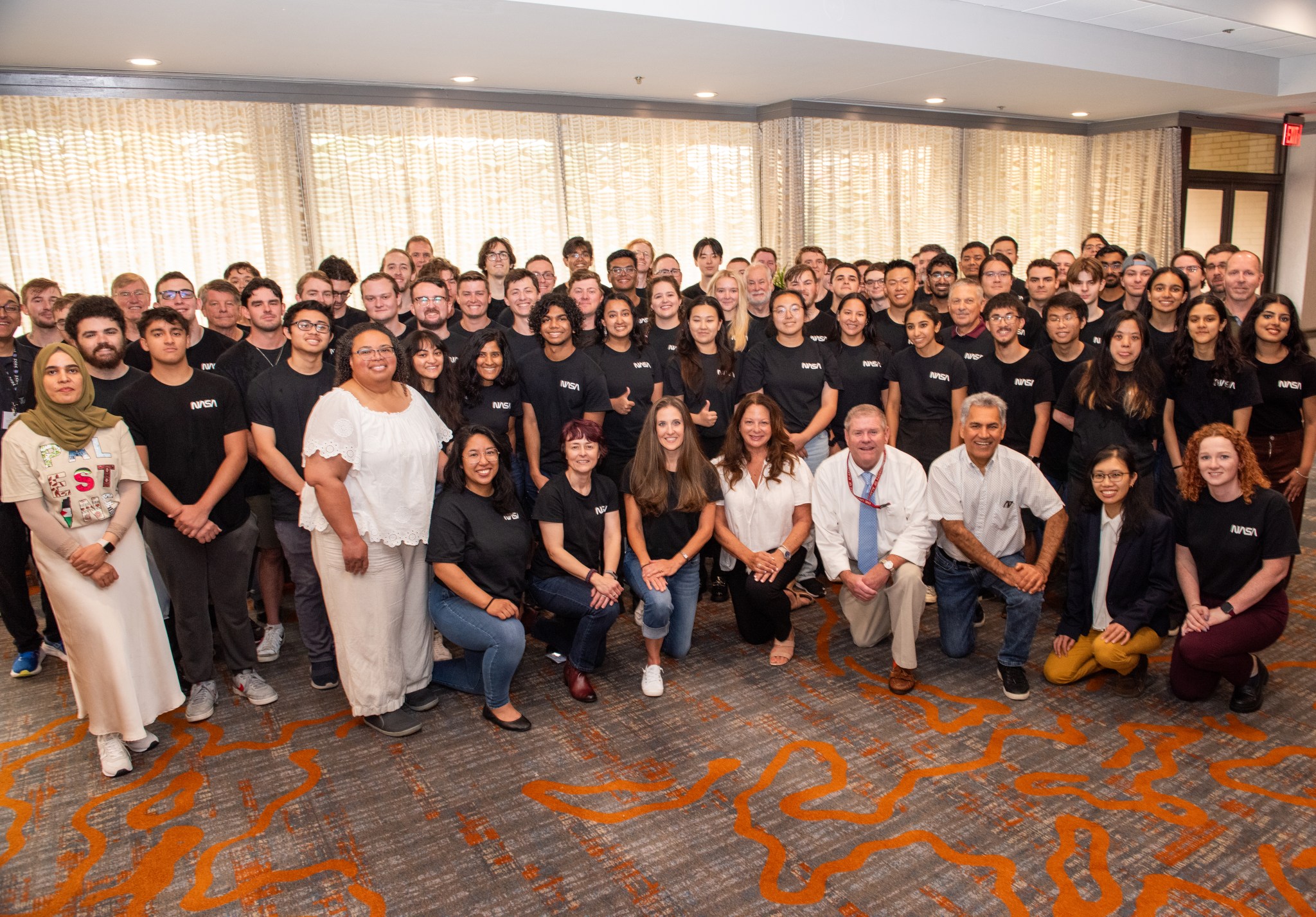
NASA's lunar exploration campaign Artemis is working to send the first woman, first person of color, and first international partner astronaut to the Moon and establish long-term lunar science and exploration capabilities. Dust mitigation during landing is one of the key challenges NASA and its Artemis partners will have to address in exploring the lunar South Pole region and establishing a long-term human presence on the Moon. Participants in the 2024 Human Lander Challenge developed proposed systems-level solutions that could be potentially implemented within the next 3-5 years to manage or prevent clouds of dust - called lunar plume surface interaction - that form as a spacecraft touches down on the Moon.
NASA announced the University of Michigan team, with their project titled, "ARC-LIGHT: Algorithm for Robust Characterization of Lunar Surface Imaging for Ground Hazards and Trajectory" as the selected overall winner and recipient of a $10,000 award June 27.
The University of Illinois, Urbana-Champaign took second place and a $5,000 award with their project, "HINDER: Holistic Integration of Navigational Dynamics for Erosion Reduction," followed by University of Colorado Boulder for their project, "Lunar Surface Assessment Tool (LSAT): A Simulation of Lunar Dust Dynamics for Risk Analysis," and a $3,000 award.
"Managing and reducing the threat of lunar dust is a formidable challenge to NASA and we are committed to real solutions for our long long-term presence on the Moon's surface," said Don Krupp, associate program manager for the HLS Program at Marshall. "A key part of NASA's mission is to build the next generation of explorers and expand our partnerships across commercial industry and the academic community to advance HLS technologies, concepts, and approaches. The Human Lander Challenge is a great example of our unique partnership with the academic community as they help provide innovative and real solutions to the unique risks and challenges of returning to the Moon."
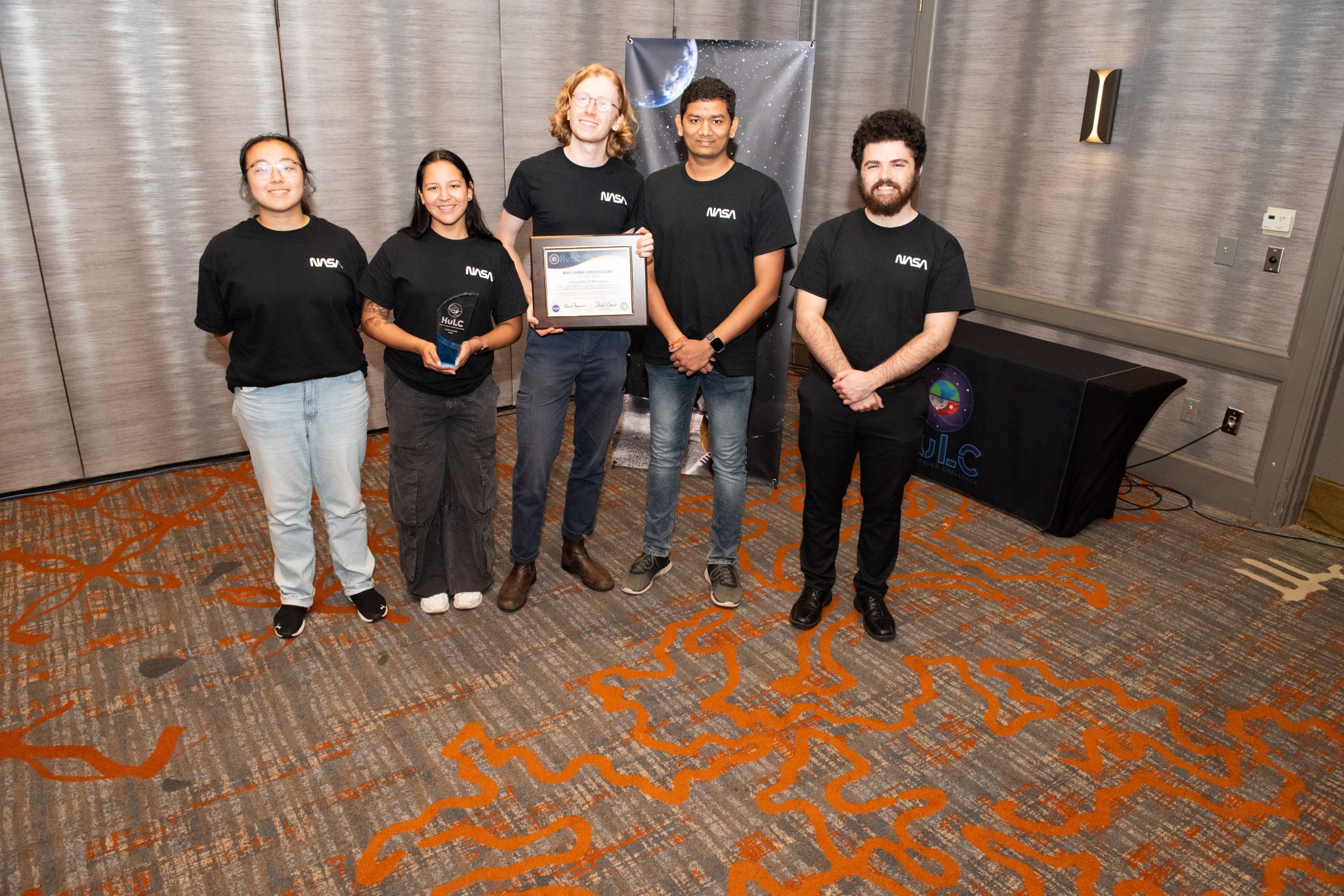
Two teams received the excellence in systems engineering award:
- Texas A&M University, "Synthetic Orbital Landing Area for Crater Elimination (SOLACE)
- Embry-Riddle Aeronautical University, Prescott, "Plume Additive for Reducing Surface Ejecta and Cratering (PARSEC)
"The caliber of solutions presented by the finalist teams to address the challenges of lunar-plume surface interaction is truly commendable," said Esther Lee, HuLC judging panel chair and aerospace engineer at NASA's Langley Research Center. "Witnessing the development of these concepts is an exciting glimpse into the promising future of aerospace leadership. It's inspiring to see so many brilliant minds coming together to solve the challenges of lunar landings and exploration. We may all come from different educational backgrounds, but our shared passion for space unites us."
Student and faculty advisor participants had the opportunity to network and interact with NASA and industry subject matter experts who are actively working on NASA's Human Landing System capabilities giving participants a unique insight to careers and operations that further the Agency's mission of human space exploration.
NASA's Human Lander Challenge is sponsored by Human Landing System Program and managed by the National Institute of Aerospace.
Learn more about NASA Exploration Systems Development Mission Directorate.
Six Adapters for Crewed Artemis Flights Tested, Built at Marshall
As a child learning about basic engineering, you probably tried and failed to join a square-shaped toy with a circular-shaped toy: you needed a third shape to act as an adapter and connect them both together. On a much larger scale, integration of NASA's powerful SLS (Space Launch System) rocket and the Orion spacecraft for the agency's Artemis campaign would not be possible without the adapters being built, tested, and refined at NASA's Marshall Space Flight Center.
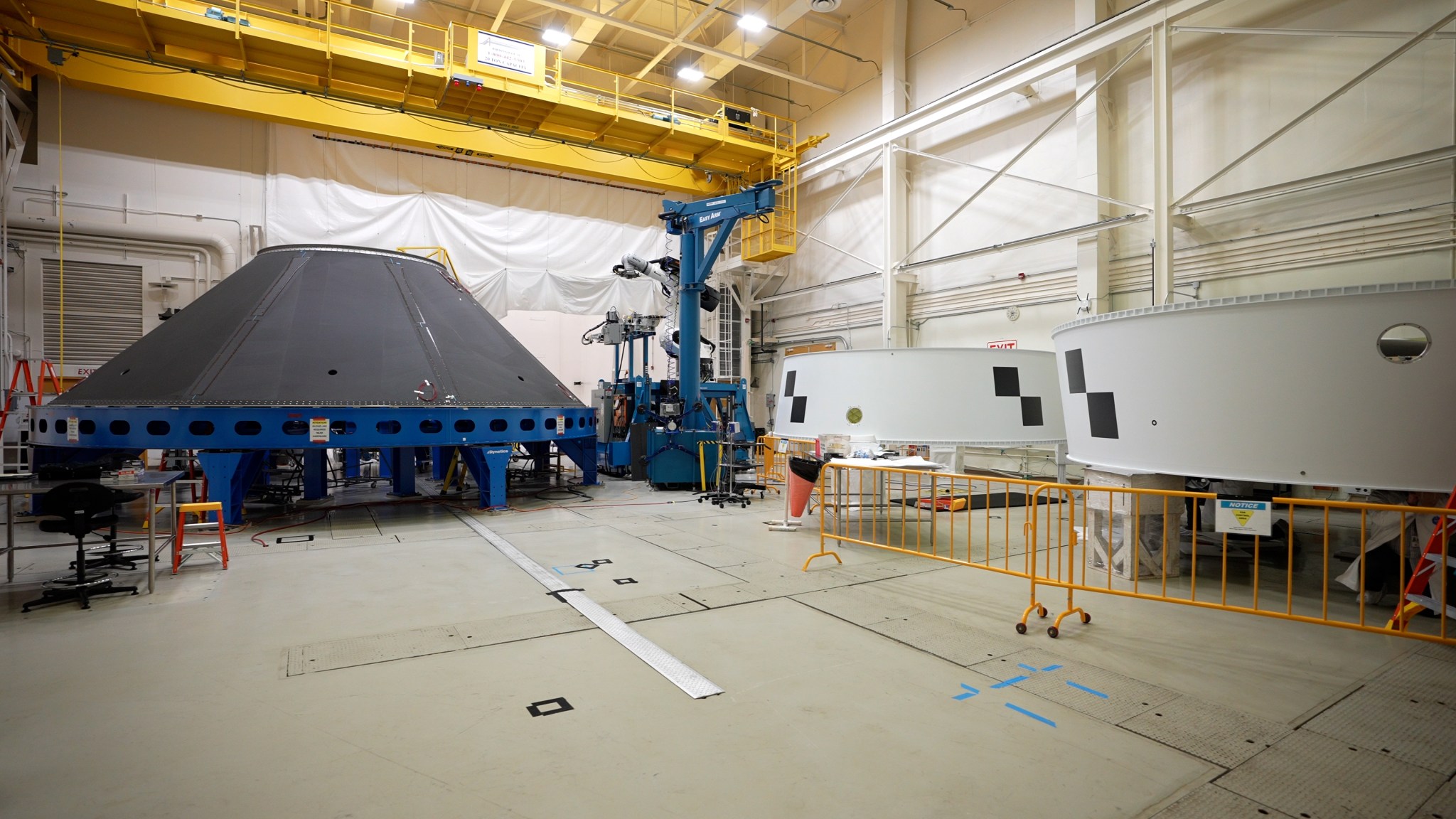
Marshall is currently home to six adapters designed to connect SLS's upper stages with the core stages and propulsion systems for future Artemis flights to the Moon.
The first three Artemis flights use the SLS Block 1 rocket variant, which can send more than 27 metric tons (59,500 pounds) to the Moon in a single launch with the assistance of the interim cryogenic propulsion stage. The propulsion stage is sandwiched between two adapters: the launch vehicle stage adapter and the Orion stage adapter.
The cone-shaped launch vehicle stage adapter provides structural strength and protects the rocket's flight computers and other delicate systems from acoustic, thermal, and vibration effects.
"The inside of the launch vehicle stage adapter for the SLS rocket uses orthogrid machining - also known as waffle pattern machining," said Keith Higginbotham, launch vehicle stage adapter hardware manager supporting the SLS Spacecraft/Payload Integration & Evolution Office at Marshall. "The aluminum alloy plus the grid pattern is lightweight but also very strong."
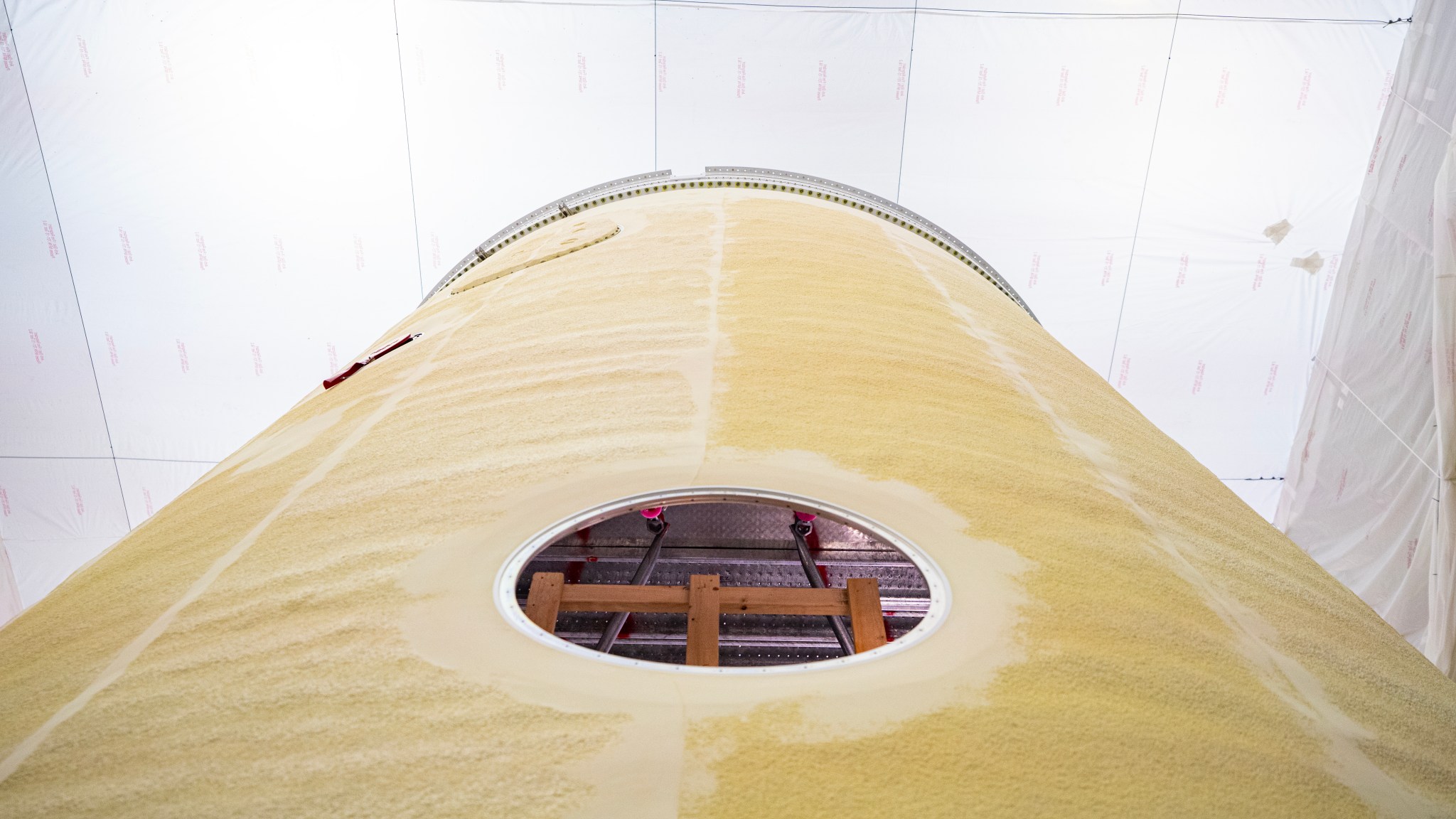
The launch vehicle stage adapter for Artemis II is at Marshall and ready for shipment to NASA's Kennedy Space Center, while engineering teams are completing outfitting and integration work on the launch vehicle stage adapter for Artemis III. These cone-shaped adapters differ from their Artemis I counterpart, featuring additional avionics protection for crew safety.
Just a few buildings over, the Orion stage adapter for Artemis II, with its unique docking target that mimics the target on the interim cryogenic propulsion stage to test Orion's handling during the piloting demonstration test, is in final outfitting prior to shipment to Kennedy for launch preparations. The five-foot-tall, ring-shaped adapter is small but mighty: in addition to having space to accommodate small secondary payloads, it contains a diaphragm that acts as a barrier to prevent gases generated during launch from entering Orion.
The Artemis III Orion stage adapter's major structure is complete and its avionics unit and diaphragm will be installed later this year.
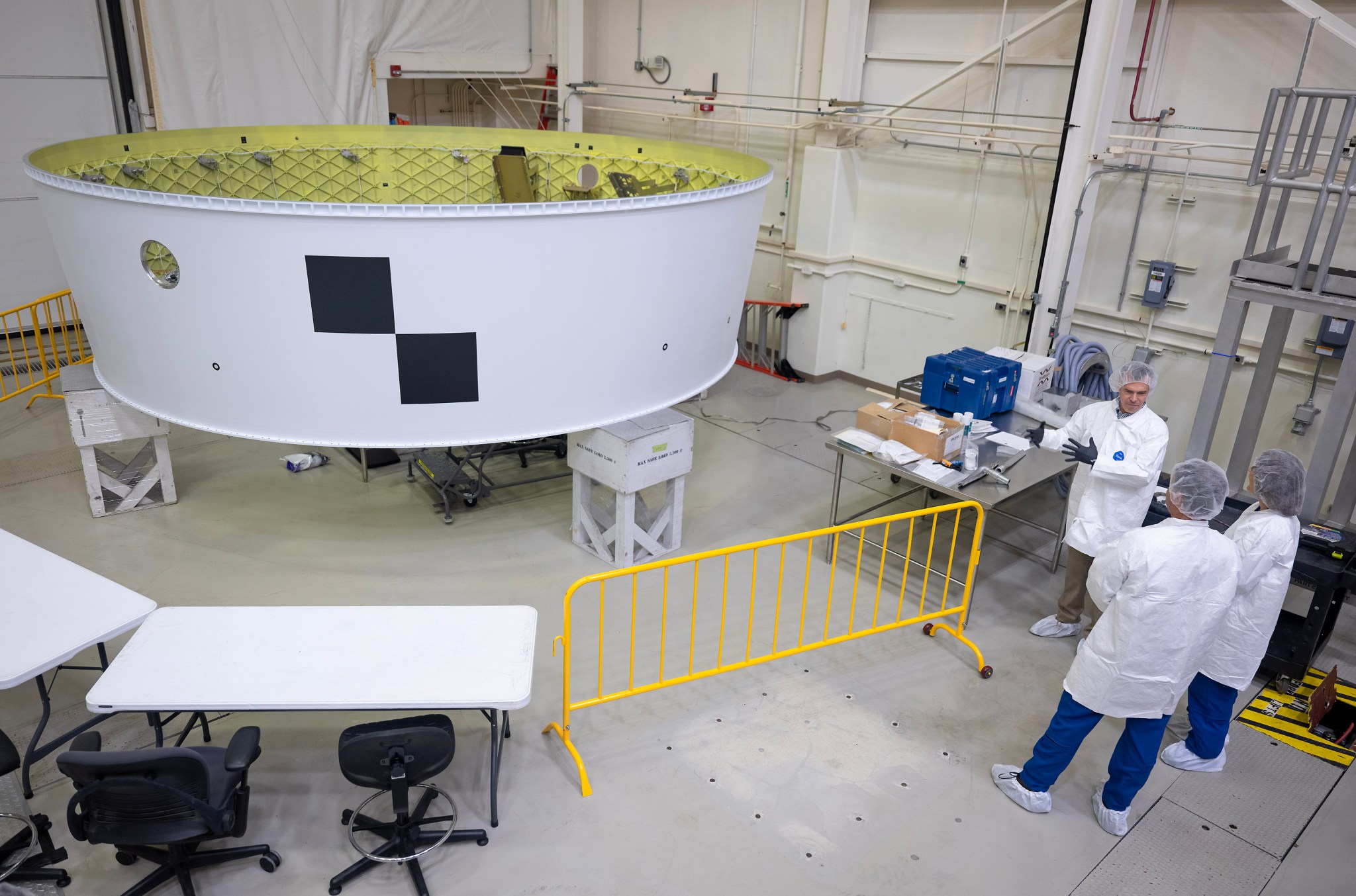
Beginning with Artemis IV, a new configuration of SLS, the SLS Block 1B, will use the new, more powerful exploration upper stage to enable more ambitious missions to deep space. The new stage requires new adapters.
The cone-shaped payload adapter - containing two aluminum rings and eight composite panels made from a graphite epoxy material - will be housed inside the universal stage adapter atop the rocket's exploration upper stage.
The payload adapter test article is being twisted, shaken, and placed under extreme pressure to check its structural strength as part of testing at Marshall. Engineers are making minor changes to the design of the flight article, such as the removal of certain vent holes, based on the latest analyses.
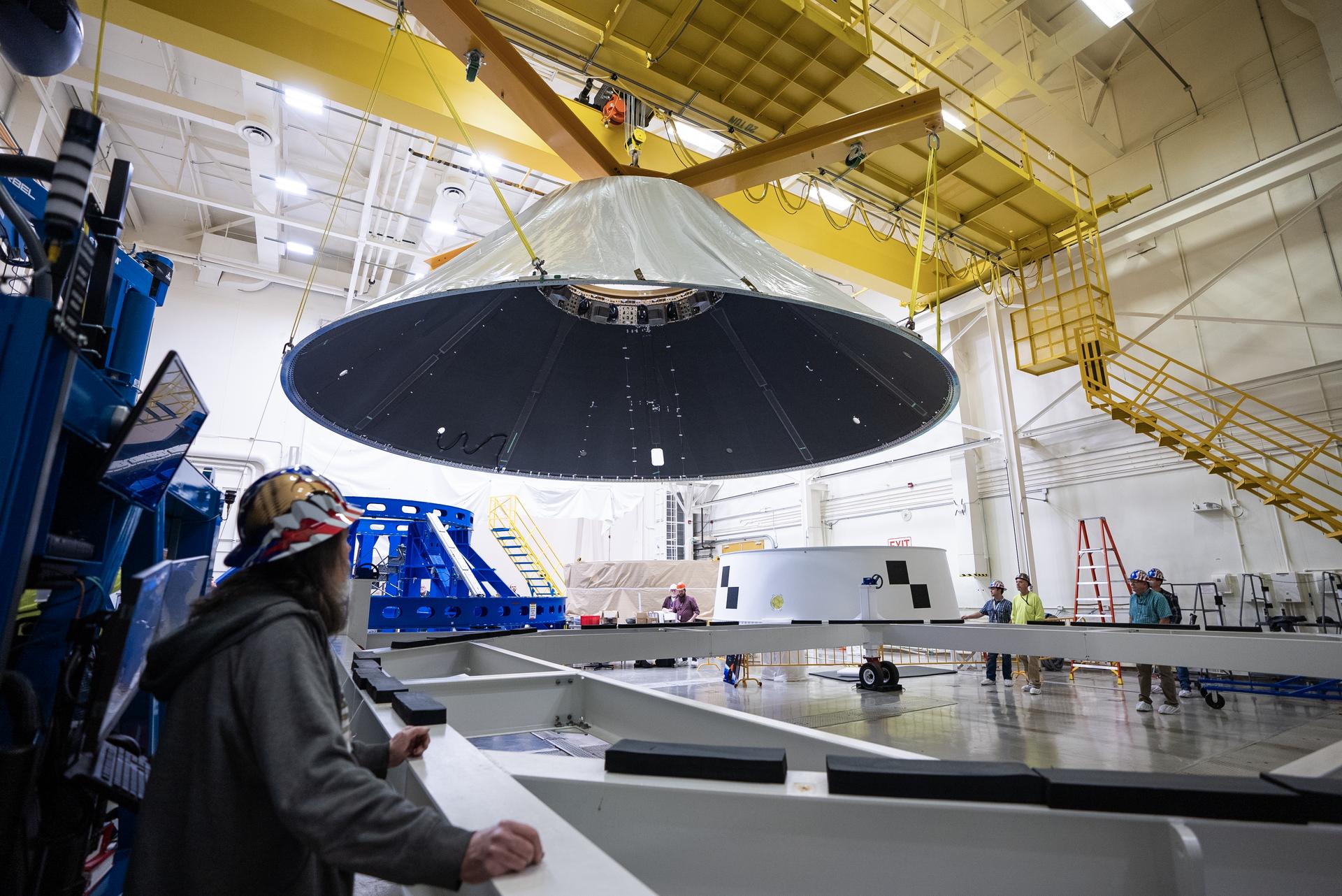
The sixth adapter at Marshall is a development test article of the universal stage adapter, which will be the largest composite structure from human spaceflight missions ever flown at 27.5 feet in diameter and 32 feet long. It is currently undergoing modal and structural testing to ensure it is light, strong, and ready to connect SLS Block 1B's exploration upper stage to Orion.
"Every pound of structure is equal to a pound of payload," says Tom Krivanek, universal stage adapter sub-element project manager at NASA's Glenn Research Center. Glenn manages the adapter for the agency. "That's why it's so valuable that the universal stage adapter be as light as possible. The universal stage adapter separates after the translunar insertion, so NASA will need to demonstrate the ability to separate cleanly in orbit in very cold conditions."
With its multipurpose testing equipment, innovative manufacturing processes, and large-scale integration facilities, Marshall facilities and capabilities enable teams to process composite hardware elements for multiple Artemis missions in parallel, providing for cost and schedule savings.
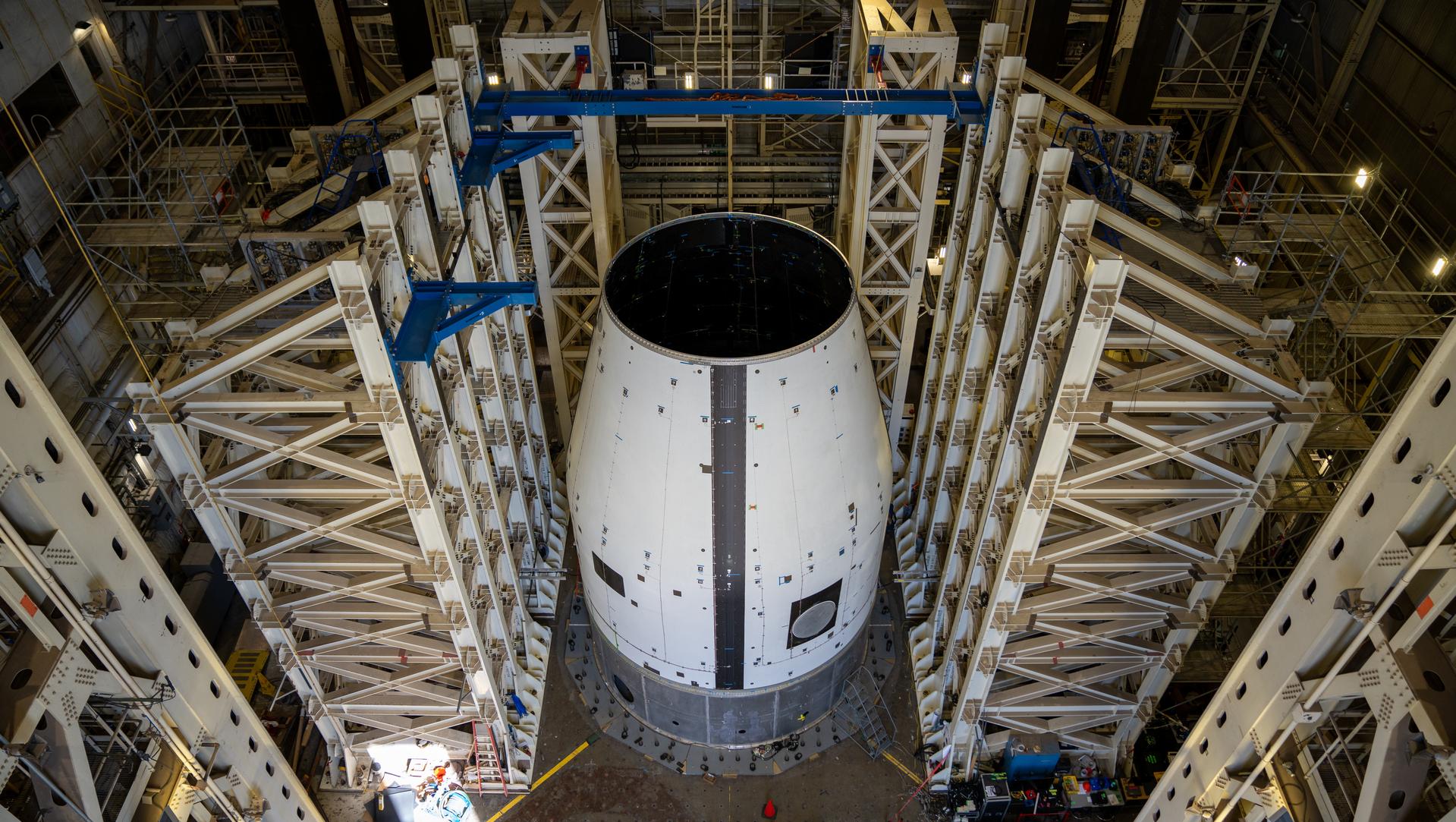
Lessons learned from testing and manufacturing hardware for the first three SLS flights in the Block 1 configuration have aided in designing and integrating the SLS Block 1B configuration.
Both adapters for the SLS Block 1 are manufactured using friction stir welding in Marshall's Materials and Processes Laboratory, a process that very reliably produces materials that are typically free of flaws.
Pioneering techniques such as determinant assembly and digital tooling ensure an efficient and uniform manufacturing process and save NASA and its partners money and time when building Block 1B's payload adapter. Structured light scanning maps each panel and ring individually to create a digital model informing technicians where holes should be drilled.
"Once the holes are put in with a hand drill located by structured light, it's simply a matter of holding the pieces together and dropping fasteners in place," Gaddes said. "It's kind of like an erector set."
From erector sets to the Moon and beyond - the principles of engineering are the same no matter what you are building.
Juno Gets a Close-Up Look at Lava Lakes on Jupiter's Moon Io
New findings from NASA's Juno probe provide a fuller picture of how widespread the lava lakes are on Jupiter's moon Io and include first-time insights into the volcanic processes at work there. These results come courtesy of Juno's Jovian Infrared Auroral Mapper (JIRAM) instrument, contributed by the Italian Space Agency, which "sees" in infrared light. Researchers published a paper on Juno's most recent volcanic discoveries on June 20 in the journal Nature Communications Earth and Environment.
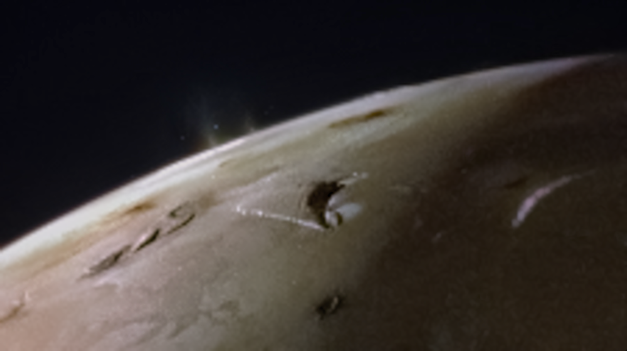
Io has intrigued the astronomers since 1610, when Galileo Galilei first discovered the Jovian moon, which is slightly larger than Earth's Moon. Some 369 years later, NASA's Voyager 1 spacecraft captured a volcanic eruption on the moon. Subsequent missions to Jupiter, with more Io flybys, discovered additional plumes - along with lava lakes. Scientists now believe Io, which is stretched and squeezed like an accordion by neighboring moons and massive Jupiter itself, is the most volcanically active world in the solar system. But while there are many theories on the types of volcanic eruptions across the surface of the moon, little supporting data exists.
In both May and October 2023, Juno flew by Io, coming within about 21,700 miles and 8,100 miles, respectively. Among Juno's instruments getting a good look at the beguiling moon was JIRAM.
Designed to capture the infrared light (which is not visible to the human eye) emerging from deep inside Jupiter, JIRAM probes the weather layer down to 30 to 45 miles below the gas giant's cloud tops. But during Juno's extended mission, the mission team has also used the instrument to study the moons Io, Europa, Ganymede, and Callisto. The JIRAM Io imagery showed the presence of bright rings surrounding the floors of numerous hot spots.
"The high spatial resolution of JIRAM's infrared images, combined with the favorable position of Juno during the flybys, revealed that the whole surface of Io is covered by lava lakes contained in caldera-like features," said Alessandro Mura, a Juno co-investigator from the National Institute for Astrophysics in Rome. "In the region of Io's surface in which we have the most complete data, we estimate about 3% of it is covered by one of these molten lava lakes." (A caldera is a large depression formed when a volcano erupts and collapses.)
JIRAM's Io flyby data not only highlights the moon's abundant lava reserves, but also provides a glimpse of what may be going on below the surface. Infrared images of several Io lava lakes show a thin circle of lava at the border, between the central crust that covers most of the lava lake and the lake's walls. Recycling of melt is implied by the lack of lava flows on and beyond the rim of the lake, indicating that there is a balance between melt that has erupted into the lava lakes and melt that is circulated back into the subsurface system.
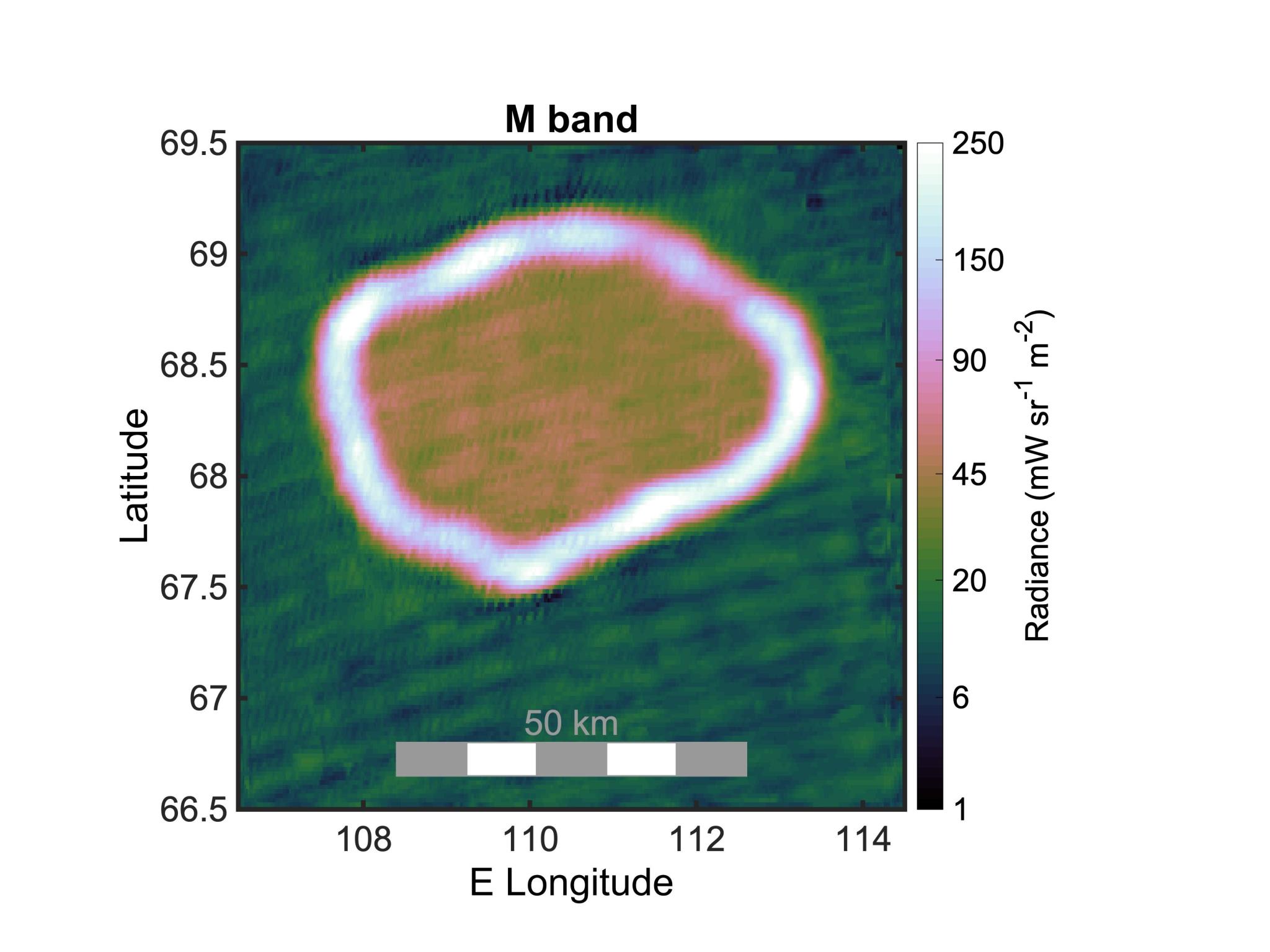
"We now have an idea of what is the most frequent type of volcanism on Io: enormous lakes of lava where magma goes up and down," Mura said. "The lava crust is forced to break against the walls of the lake, forming the typical lava ring seen in Hawaiian lava lakes. The walls are likely hundreds of meters high, which explains why magma is generally not observed spilling out of the paterae" - bowl-shaped features created by volcanism - "and moving across the moon's surface."
JIRAM data suggests that most of the surface of these Io hot spots is composed of a rocky crust that moves up and down cyclically as one contiguous surface due to the central upwelling of magma. In this hypothesis, because the crust touches the lake's walls, friction keeps it from sliding, causing it to deform and eventually break, exposing lava just below the surface.
An alternative hypothesis remains in play: Magma is welling up in the middle of the lake, spreading out and forming a crust that sinks along the rim of the lake, exposing lava.
"We are just starting to wade into the JIRAM results from the close flybys of Io in December 2023 and February 2024," said Scott Bolton, principal investigator for Juno at the Southwest Research Institute in San Antonio. "The observations show fascinating new information on Io's volcanic processes. Combining these new results with Juno's longer-term campaign to monitor and map the volcanoes on Io's never-before-seen north and south poles, JIRAM is turning out to be one of the most valuable tools to learn how this tortured world works."
Juno executed its 62nd flyby of Jupiter - which included an Io flyby at an altitude of about 18,175 miles - on June 13. The 63rd flyby of the gas giant is scheduled for July 16.
NASA's Jet Propulsion Laboratory, a division of Caltech in Pasadena, California, manages the Juno mission for the principal investigator, Scott Bolton, of the Southwest Research Institute in San Antonio. Juno is part of NASA's New Frontiers Program, which is managed at NASA's Marshall Space Flight Center for the agency's Science Mission Directorate. The Italian Space Agency (ASI) funded the Jovian InfraRed Auroral Mapper. Lockheed Martin Space in Denver built and operates the spacecraft.
Surprising Phosphate Finding in NASA's OSIRIS-REx Asteroid Sample
Scientists have eagerly awaited the opportunity to dig into the 4.3-ounce (121.6-gram) pristine asteroid Bennu sample collected by NASA's OSIRIS-REx (Origins, Spectral Interpretation, Resource Identification, and Security - Regolith Explorer) mission since it was delivered to Earth last fall. They hoped the material would hold secrets of the solar system's past and the prebiotic chemistry that might have led to the origin of life on Earth. An early analysis of the Bennu sample, published June 26 in Meteoritics & Planetary Science, demonstrates this excitement was warranted.
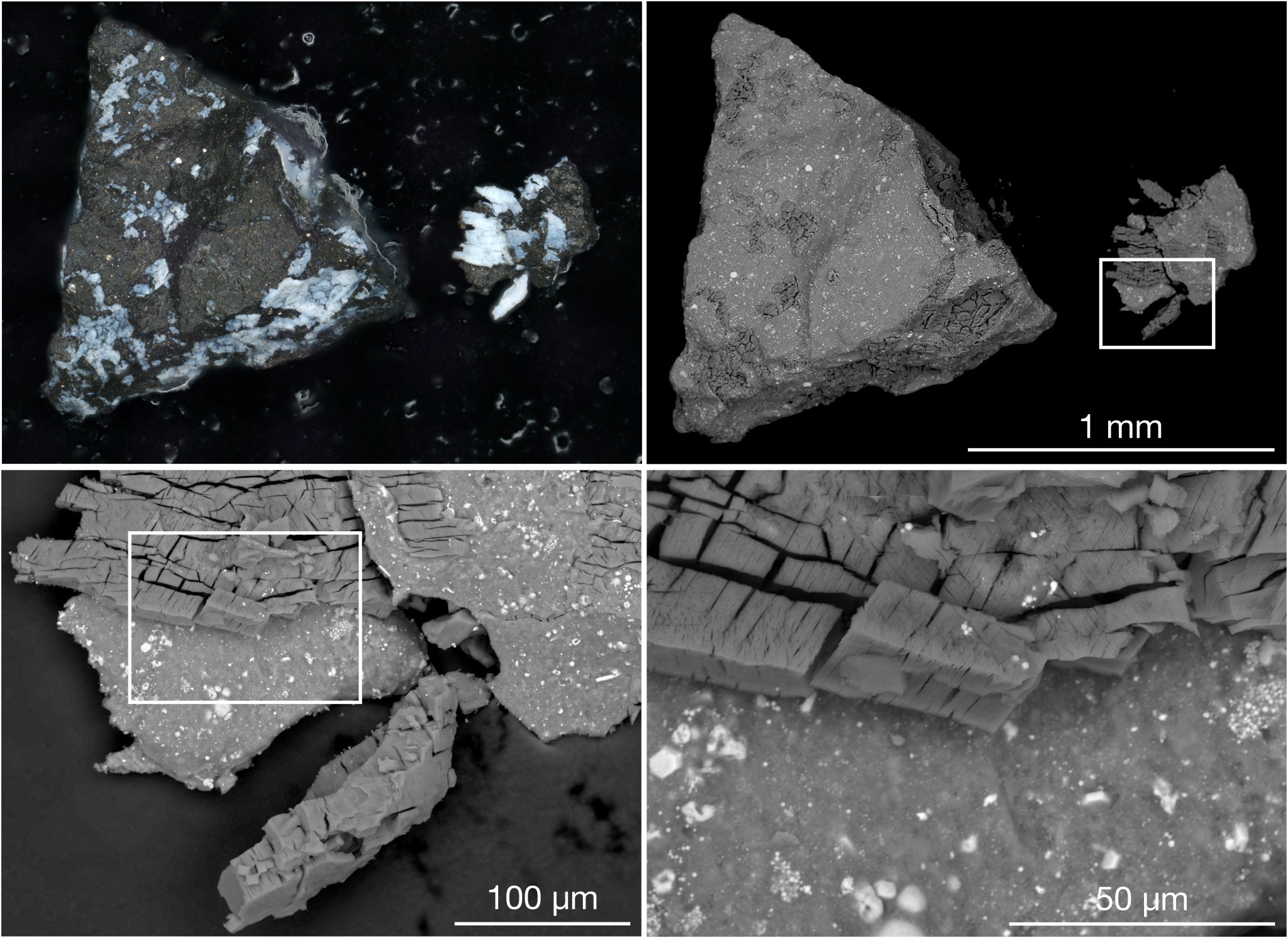
The OSIRIS-REx Sample Analysis Team found that Bennu contains the original ingredients that formed our solar system. The asteroid's dust is rich in carbon and nitrogen, as well as organic compounds, all of which are essential components for life as we know it. The sample also contains magnesium-sodium phosphate, which was a surprise to the research team, because it wasn't seen in the remote sensing data collected by the spacecraft at Bennu. Its presence in the sample hints that the asteroid could have splintered off from a long-gone, tiny, primitive ocean world.
Analysis of the Bennu sample unveiled intriguing insights into the asteroid's composition. Dominated by clay minerals, particularly serpentine, the sample mirrors the type of rock found at mid-ocean ridges on Earth, where material from the mantle, the layer beneath Earth's crust, encounters water.
This interaction doesn't just result in clay formation; it also gives rise to a variety of minerals like carbonates, iron oxides, and iron sulfides. But the most unexpected discovery is the presence of water-soluble phosphates. These compounds are components of biochemistry for all known life on Earth today.
While a similar phosphate was found in the asteroid Ryugu sample delivered by JAXA's (Japan Aerospace Exploration Agency) Hayabusa2 mission in 2020, the magnesium-sodium phosphate detected in the Bennu sample stands out for its purity - that is, the lack of other materials in the mineral - and the size of its grains, unprecedented in any meteorite sample.
The finding of magnesium-sodium phosphates in the Bennu sample raises questions about the geochemical processes that concentrated these elements and provides valuable clues about Bennu's historic conditions.
"The presence and state of phosphates, along with other elements and compounds on Bennu, suggest a watery past for the asteroid," said Dante Lauretta, co-lead author of the paper and principal investigator for OSIRIS-REx at the University of Arizona, Tucson. "Bennu potentially could have once been part of a wetter world. Although, this hypothesis requires further investigation."
"OSIRIS-REx gave us exactly what we hoped: a large pristine asteroid sample rich in nitrogen and carbon from a formerly wet world," said Jason Dworkin, a co-author on the paper and the OSIRIS-REx project scientist at NASA's Goddard Space Flight Center.
Despite its possible history of interaction with water, Bennu remains a chemically primitive asteroid, with elemental proportions closely resembling those of the Sun.
"The sample we returned is the largest reservoir of unaltered asteroid material on Earth right now," Lauretta said.
This composition offers a glimpse into the early days of our solar system, over 4.5 billion years ago. These rocks have retained their original state, having neither melted nor resolidified since their inception, affirming their ancient origins.
The team has confirmed the asteroid is rich in carbon and nitrogen. These elements are crucial in understanding the environments where Bennu's materials originated and the chemical processes that transformed simple elements into complex molecules, potentially laying the groundwork for life on Earth.
"These findings underscore the importance of collecting and studying material from asteroids like Bennu - especially low-density material that would typically burn up upon entering Earth's atmosphere," Lauretta said. "This material holds the key to unraveling the intricate processes of solar system formation and the prebiotic chemistry that could have contributed to life emerging on Earth."
Dozens more labs in the United States and around the world will receive portions of the Bennu sample from NASA's Johnson Space Center in the coming months, and many more scientific papers describing analyses of the Bennu sample are expected in the next few years from the OSIRIS-REx Sample Analysis Team.
"The Bennu samples are tantalizingly beautiful extraterrestrial rocks," said Harold Connolly, co-lead author on the paper and OSIRIS-REx mission sample scientist at Rowan University in Glassboro, New Jersey. "Each week, analysis by the OSIRIS-REx Sample Analysis Team provides new and sometimes surprising findings that are helping place important constraints on the origin and evolution of Earth-like planets."
Launched on Sept. 8, 2016, the OSIRIS-REx spacecraft traveled to near-Earth asteroid Bennu and collected a sample of rocks and dust from the surface. OSIRIS-REx, the first U.S. mission to collect a sample from an asteroid, delivered the sample to Earth on Sept. 24, 2023.
NASA's Goddard Space Flight Center provided overall mission management, systems engineering, and the safety and mission assurance for OSIRIS-REx. Dante Lauretta of the University of Arizona, Tucson, is the principal investigator. The university leads the science team and the mission's science observation planning and data processing. Lockheed Martin Space in Littleton, Colorado, built the spacecraft and provided flight operations. Goddard and KinetX Aerospace were responsible for navigating the OSIRIS-REx spacecraft. Curation for OSIRIS-REx takes place at NASA Johnson. International partnerships on this mission include the OSIRIS-REx Laser Altimeter instrument from CSA (Canadian Space Agency) and asteroid sample science collaboration with JAXA's Hayabusa2 mission. OSIRIS-REx is the third mission in NASA's New Frontiers Program, managed by NASA's Marshall Space Flight Center for the agency's Science Mission Directorate.
Webb Captures Celestial Fireworks Around Forming Star
The cosmos seems to come alive with a crackling explosion of pyrotechnics in this new image from NASA's James Webb Space Telescope. Taken with Webb's MIRI (Mid-Infrared Instrument), this fiery hourglass marks the scene of a very young object in the process of becoming a star. A central protostar grows in the neck of the hourglass, accumulating material from a thin protoplanetary disk, seen edge-on as a dark line.

The protostar, a relatively young object of about 100,000 years, is still surrounded by its parent molecular cloud, or large region of gas and dust. Webb's previous observation of L1527, with NIRCam (Near-Infrared Camera), allowed us to peer into this region and revealed this molecular cloud and protostar in opaque, vibrant colors.
Both NIRCam and MIRI show the effects of outflows, which are emitted in opposite directions along the protostar's rotation axis as the object consumes gas and dust from the surrounding cloud. These outflows take the form of bow shocks to the surrounding molecular cloud, which appear as filamentary structures throughout. They are also responsible for carving the bright hourglass structure within the molecular cloud as they energize, or excite, the surrounding matter and cause the regions above and below it to glow. This creates an effect reminiscent of fireworks brightening a cloudy night sky. Unlike NIRCam, however, which mostly shows the light that is reflected off dust, MIRI provides a look into how these outflows affect the region's thickest dust and gases.
The areas colored here in blue, which encompass most of the hourglass, show mostly carbonaceous molecules known as polycyclic aromatic hydrocarbons. The protostar itself and the dense blanket of dust and a mixture of gases that surround it are represented in red. (The sparkler-like red extensions are an artifact of the telescope's optics). In between, MIRI reveals a white region directly above and below the protostar, which doesn't show as strongly in the NIRCam view. This region is a mixture of hydrocarbons, ionized neon, and thick dust, which shows that the protostar propels this matter quite far away from it as it messily consumes material from its disk.
As the protostar continues to age and release energetic jets, it'll consume, destroy, and push away much of this molecular cloud, and many of the structures we see here will begin to fade. Eventually, once it finishes gathering mass, this impressive display will end, and the star itself will become more apparent, even to our visible-light telescopes.
The combination of analyses from both the near-infrared and mid-infrared views reveal the overall behavior of this system, including how the central protostar is affecting the surrounding region. Other stars in Taurus, the star-forming region where L1527 resides, are forming just like this, which could lead to other molecular clouds being disrupted and either preventing new stars from forming or catalyzing their development.
The James Webb Space Telescope is the world's premier space science observatory. Webb is solving mysteries in our solar system, looking beyond to distant worlds around other stars, and probing the mysterious structures and origins of our universe and our place in it. Webb is an international program led by NASA with its partners, ESA (European Space Agency) and CSA (Canadian Space Agency). Several NASA centers contributed to the project, including NASA's Marshall Space Flight Center.
Enhancing Decision-Making with NASA SPoRT: From Earth Science to Action
By Paola Pinto
During summer months, lightning-related injuries and fatalities rise mainly because of the increase in outdoor activities. Staying informed and cautious is crucial to ensure safety during these times. That is why making timely decisions and preventing potential hazards using tools like the Stoplight Product from NASA's Short-term Prediction Research and Transition (SPoRT) Center is so important.
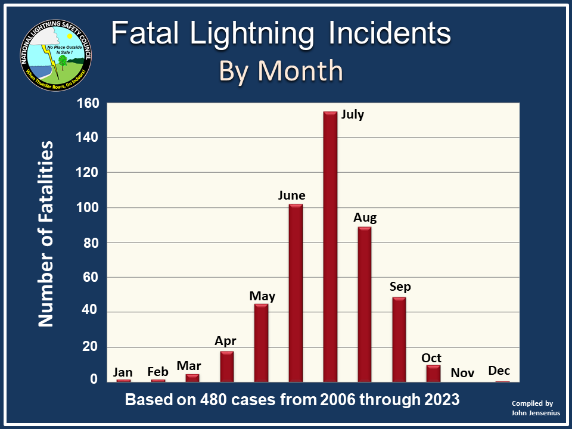
For instance, at last year's Rock the South concert in Cullman, Alabama, the National Weather Service (NWS) in Huntsville used the Stoplight Product to effectively communicate the lightning threat to concert emergency managers, demonstrating its practical application in safeguarding public events.
The popular sayings, "When thunder roars, go indoors" and "See a flash, dash inside," are common reactive responses to severe weather. According to NOAA's lightning safety protocols, waiting 30 minutes after the last lightning strike is recommended before resuming outdoor activities. However, tools like the Stoplight Product provide real-time lightning activity data, helping individuals and organizations make informed safety choices before weather conditions worsen. Whether for outdoor events, construction sites, or recreational activities, this product enables people to easily determine when lightning was last detected in their area, ensuring better safety and preparedness.
In collaboration with NASA Marshall Space Flight Center's Emergency Operations Center and the National Weather Service in Huntsville, SPoRT has developed innovative tools like the Stoplight Product to empower communities and organizations to take proactive preventive measures. SPoRT's tools are part of a broader effort to transition research findings into practical applications that benefit forecasters and communities.
Kelley Murphy, a research associate at the University of Alabama in Huntsville, frequently interacts with users to train them on how to use the NASA SPoRT Stoplight Product during convective weather events. She said the tool leverages data from the Geostationary Lightning Mapper (GLM) on NOAA's GOES-16 satellite, which continuously monitors lightning over the United States with high resolution. The Stoplight Product visually represents recent lightning activity to help users make informed decisions about outdoor safety.
Murphy said the Stoplight Product uses GLM Flash Extent Density data to determine the age and location of lightning flashes. GLM pixels are colored based on how recently lightning occurred, creating an easy-to-interpret visual aid of lightning within the last 30 minutes. Red indicates lightning within the last 10 minutes, yellow for 10-20 minutes, and green for 20-30 minutes, with the color disappearing after 30 minutes without lightning. There is also an option for color-blind users embedded in the tool.
Kristopher White is the Applications Integration Meteorologist and senior forecaster at the Huntsville NWS office, spending half his time with NASA SPoRT. White plays a key role in transitioning research into operational use, coordinating the use of these tools within the NWS, and ensuring that forecasters are trained and equipped to utilize them effectively.
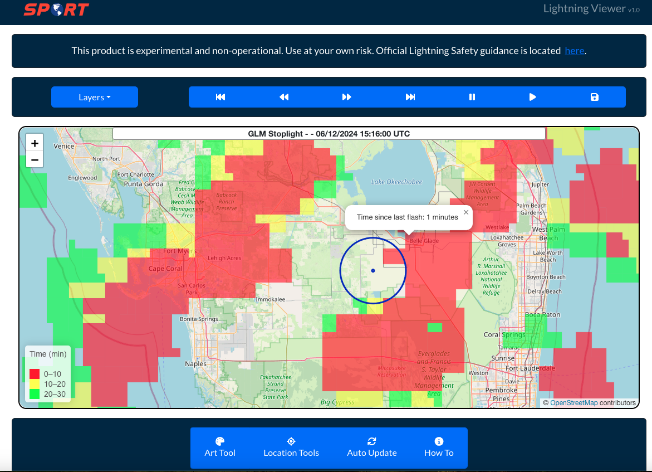
White said this product has received positive feedback from various NWS offices across the U.S. Forecasters have reported utilizing the tool to monitor storms and make decisions during events, emphasizing its practical value in real-world scenarios.
One forecaster from NWS Raleigh noted that they were able to warn about lightning at a 1000+ attendee event; "We were able to alert them that lightning was nearby and then gave the all-clear once it moved out of the critical area." Another forecaster from NWS Sullivan stated, "There's a lot of good stuff out there that we're using to paint the picture for us and the decision-makers, but the GLM Stoplight Product has been one of our 'go-to's' for assessing how long it's been since the last flash." This ability to provide real-time lightning information aids forecasters in relaying crucial data to emergency managers, supporting public safety efforts.
Looking ahead, the SPoRT team is working on enhancements to the Stoplight Product, incorporating ground-based lightning detection data to improve accuracy. This new version seeks to address issues such as the parallax effect, where the satellite's perspective can slightly shift the perceived location of lightning strikes. By combining satellite and ground-based data, the improved product will offer more precise information, enhancing its utility for lightning safety.
As we move through the peak months of the lightning season - June, July, and August - tools like these become even more helpful. Murphy and White stress the value of using these resources for professional meteorologists and the public. The Stoplight Product is GPS-enabled and available in a custom viewer that can be accessed on both computers and mobile devices, allowing individuals to make safer choices when engaging in outdoor activities, particularly during the summer weather.
On their seasonal outlook, NOAA's Climate Prediction Center suggests above-normal precipitation for much of the Southeast and Eastern Seaboard this year, which could imply increased lightning activity. This emphasizes the need for reliable tools to mitigate lightning-related risks.
Lightning Safety Awareness Week, from June 23-29, highlighted the importance of taking safety measures during peak lightning season. SPoRT's Stoplight Product and other tools represent significant advancements in lightning detection and decision support, helping forecasters and the public stay informed and safe. As we navigate this season, utilizing these resources will be essential in reducing the impact of lightning-related hazards.
Pinto is a research associate at the University of Alabama in Huntsville, with a focus on communications, supporting NASA SPoRT.






